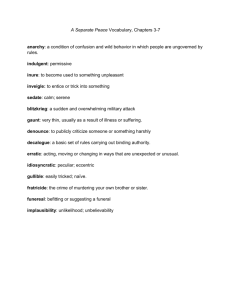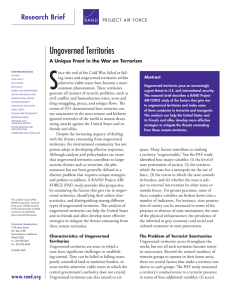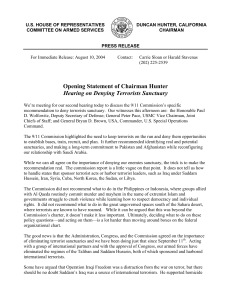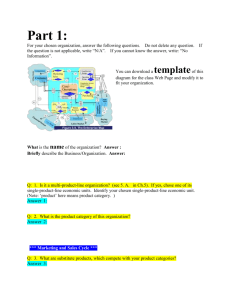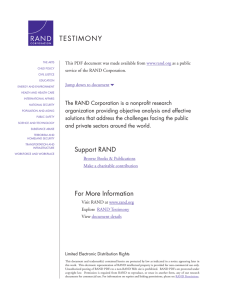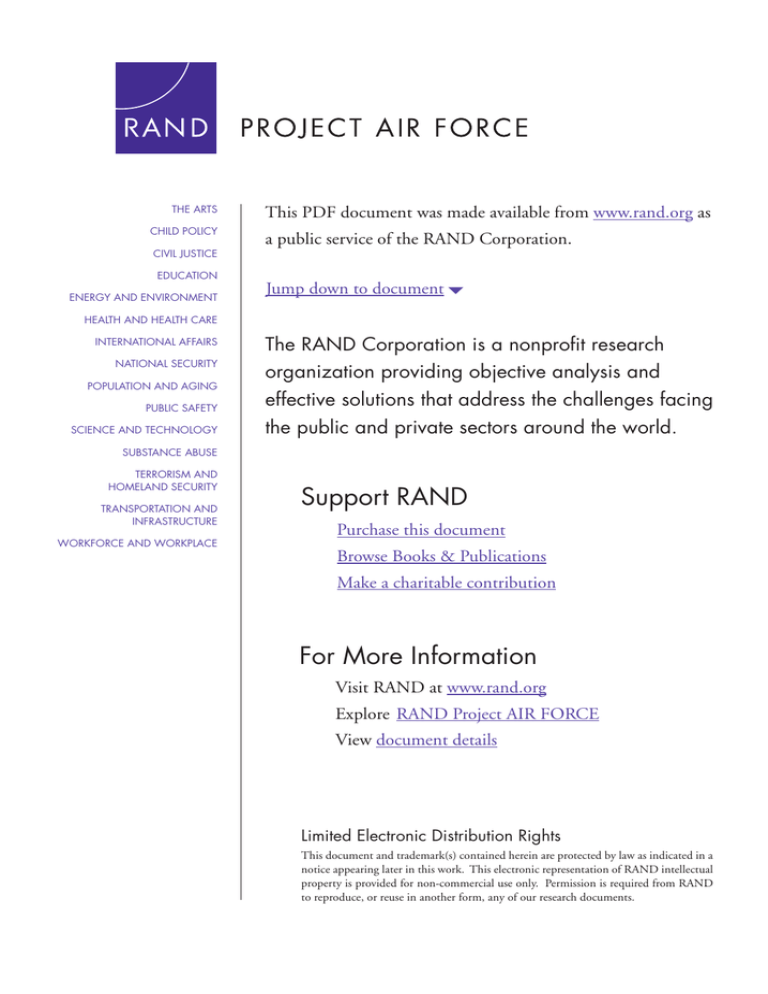
THE ARTS
CHILD POLICY
CIVIL JUSTICE
EDUCATION
ENERGY AND ENVIRONMENT
This PDF document was made available from www.rand.org as
a public service of the RAND Corporation.
Jump down to document6
HEALTH AND HEALTH CARE
INTERNATIONAL AFFAIRS
NATIONAL SECURITY
POPULATION AND AGING
PUBLIC SAFETY
SCIENCE AND TECHNOLOGY
The RAND Corporation is a nonprofit research
organization providing objective analysis and
effective solutions that address the challenges facing
the public and private sectors around the world.
SUBSTANCE ABUSE
TERRORISM AND
HOMELAND SECURITY
TRANSPORTATION AND
INFRASTRUCTURE
WORKFORCE AND WORKPLACE
Support RAND
Purchase this document
Browse Books & Publications
Make a charitable contribution
For More Information
Visit RAND at www.rand.org
Explore RAND Project AIR FORCE
View document details
Limited Electronic Distribution Rights
This document and trademark(s) contained herein are protected by law as indicated in a
notice appearing later in this work. This electronic representation of RAND intellectual
property is provided for non-commercial use only. Permission is required from RAND
to reproduce, or reuse in another form, any of our research documents.
This product is part of the RAND Corporation monograph series. RAND
monographs present major research findings that address the challenges facing
the public and private sectors. All RAND monographs undergo rigorous peer
review to ensure high standards for research quality and objectivity.
UNGOVERNED
TERRITORIES
Understanding and Reducing Terrorism Risks
Angel Rabasa • Steven Boraz • Peter Chalk • Kim Cragin • Theodore W. Karasik
Jennifer D. P. Moroney • Kevin A. O’Brien • John E. Peters
Prepared for the United States Air Force
Approved for public release, distribution unlimited
PR OJ ECT AIR FORC E
The research described in this report was sponsored by the United States
Air Force under Contract F49642-01-C-0003. Further information may
be obtained from the Strategic Planning Division, Directorate of Plans,
Hq USAF.
Library of Congress Cataloging-in-Publication Data
Ungoverned territories : understanding and reducing terrorism risks / Angel Rabasa
... [et al.].
p. cm.
Includes bibliographical references.
ISBN 978-0-8330-4152-4 (pbk. : alk. paper)
1. Terrorism—Prevention—Case studies. 2. Political stability—Case studies.
3. Security, International. I. Rabasa, Angel.
HV6431.U45 2007
363.325'17—dc22
2007023733
The RAND Corporation is a nonprofit research organization providing
objective analysis and effective solutions that address the challenges
facing the public and private sectors around the world. R AND’s
publications do not necessarily reflect the opinions of its research clients
and sponsors.
R® is a registered trademark.
© Copyright 2007 RAND Corporation
All rights reserved. No part of this book may be reproduced in any
form by any electronic or mechanical means (including photocopying,
recording, or information storage and retrieval) without permission in
writing from RAND.
Published 2007 by the RAND Corporation
1776 Main Street, P.O. Box 2138, Santa Monica, CA 90407-2138
1200 South Hayes Street, Arlington, VA 22202-5050
4570 Fifth Avenue, Suite 600, Pittsburgh, PA 15213-2665
RAND URL: http://www.rand.org/
To order RAND documents or to obtain additional information, contact
Distribution Services: Telephone: (310) 451-7002;
Fax: (310) 451-6915; Email: order@rand.org
Summary
This book examines “ungoverned territories” and the challenges that these areas pose
to U.S. national security as breeding grounds for terrorism and criminal activities and
launching pads for attacks against the United States and Western interests.
For the purpose of this investigation, we define an ungoverned territory as an
area in which a state faces significant challenges in establishing control. Ungoverned
territories can be failed or failing states, poorly controlled land or maritime borders,
or areas within otherwise viable states where the central government’s authority does
not extend. Ungoverned territories can also extend to airspace, for instance, air routes
through South and Central America and the Caribbean that the countries affected are
unable to control—routes that drug smugglers use to transport illegal drugs.
Research Approach
Eight case studies, covering the range of ungoverned territories, served as our primary research vehicle: the Pakistani-Afghan border region; the Arabian Peninsula; the
Sulawesi-Mindanao arc in Southeast Asia; the East African corridor from Sudan and
the Horn of Africa to Mozambique and Zimbabwe; West Africa from Nigeria westward; the North Caucasus; the Colombian-Venezuelan border; and the GuatemalaChiapas (Mexico) border. They are distributed through four continents and include
both Muslim and non-Muslim regions. Four of the cases correspond to areas identified
as terrorist sanctuaries in the 9/11 Commission Report. Other relevant selection factors included a history of U.S. involvement, whether the area was a theater of ongoing
or possible U.S. military operations, the likelihood that U.S. policy or behavior toward
the region would affect Washington’s relations with other countries, and the region’s
relevance to the global war on terrorism.
To examine these cases, we identified two dimensions that provide the basic framework for the analysis. We refer to these dimensions as ungovernability and conduciveness to terrorist or insurgent presence. Ungovernability means that, in these regions,
the state is unable or unwilling to perform its functions. This is not to say that these
territories are devoid of governance. Rather, the structures of authority that do exist
xv
xvi
Ungoverned Territories: Understanding and Reducing Terrorism Risks
are not related to the formal institutions of the state. We will have more to say about
the relationship between formal and informal forms of authority in our discussion of
the dimensions of ungovernability in Chapter Two. We measure ungovernability using
four variables: (1) the level of state penetration of society; (2) the extent to which the
state has a monopoly on the use of force; (3) the extent to which the state controls its
borders; and (4) whether the state is subject to external intervention by other states.
For greater precision, some of the more complex variables are broken down into
a number of indicators. For instance, state penetration of society can be measured in
terms of the presence or absence of state institutions; the state of the physical infrastructure; the prevalence of the informal or gray economy; and social and cultural
resistance to state penetration.
Not all ungoverned territories are equally suitable as terrorist sanctuaries or conducive to the presence of terrorist and insurgent groups. To complete our analytical
framework, we added the dimension of conduciveness. Conduciveness is measured by
the following four variables: (1) adequacy of infrastructure and operational access, (2)
availability of sources of income, (3) favorable demographics, and (4) invisibility.
Adequacy of infrastructure means that a terrorist group must have a basic communications and transportation network and the means of transferring funds in order
to operate and access its targets. When funding from external sources is not available,
terrorists need to raise money locally in order to fund their operations. The variables
and indicators used in this study are shown in Tables S.1 and S.2.
Table S.1
Indicators of Ungovernability
Variable
Lack of state penetration
Absence of state institutions
Lack of physical infrastructure
Corruption and the prevalence of the informal economy
Social/cultural resistance
Lack of monopoly of force
Illegal armed groups
Criminal networks
Population with access to arms
Lack of border controls
External interference
Summary
xvii
Table S.2
Indicators of Conduciveness to Terrorist Presence
Variable
Adequacy of infrastructure and operational access
Transportation and communications
Financial
Sources of income
Favorable demographics
Presence of extremist groups
Supporting social norms
Preexisting state of violence
Presence of favorably disposed NGOs or social
assistance programs open to exploitation
Criminal syndicates available for hire
Invisibility
Analysis of the Case Studies
In our analyses, we outline the dominant features of each ungoverned territory and
evaluate each region on the basis of ungovernability and conduciveness to terrorists.
We scored each region based on the variables and indicators described above, using the
following values: 1 = low, 2 = medium, and 3 = high. These scores, summarized in the
tables in the appendix, are based on the case studies in Chapters Six through Thirteen.
We also provide separate tables for three multicountry case studies: the Arabian Peninsula, the East Africa corridor, and West Africa.
The presence of organized armed groups outside the state’s direct control is a
common characteristic of three of the two-country regions (the Pakistani-Afghan
border, Sulawesi-Mindanao, and the Colombian-Venezuelan border); two cases within
the Arabian Peninsula (Saudi Arabia and Yemen); and two cases in East Africa (Somalia and Sudan). (Note that it is not uncommon for the government or ruling factions
to rely on extralegal armed groups—for instance, the Janjaweed militia in Darfur—to
enforce their will.) Regions that score high for the presence of armed groups also rate
medium or high with regard to the absence of state institutions, as we would expect.
But most interesting is that they all show a considerable lack of border control. This
suggests that border control is a key variable in explaining ungoverned territories and
may be a strategic factor in managing them.
Interference by external states does not appear to be an important factor, except
to the extent that Russia is an “external state” in some parts of the North Caucasus.
Venezuela’s interference has the potential to influence the course of the Colombian
conflict, but such a level of interference has not yet materialized. Similarly, Iran may
have the potential to destabilize some of the Gulf states, and Ethiopia can exert pres-
xviii
Ungoverned Territories: Understanding and Reducing Terrorism Risks
sure to influence developments in Somalia. However, if political systems are not completely aligned with state institutions and national boundaries, the distinction between
state interference and the interference of foreign networks (e.g., Saudi “charities”) may
be blurred.
Our research also shows that favorable demographic and social conditions are a
key factor in a region’s conduciveness to terrorist presence. This complex variable comprises the presence of extremist groups, supportive social norms among the population,
a preexisting state of violence, the presence of informal social networks that can be
exploited by terrorists, and the presence of criminal syndicates that can serve as contractors to terrorist groups.
Supportive social norms, a key indicator of favorable demographic and social conditions, are closely related to social and cultural resistance, which in turn indicate the
lack of state penetration. The following ungoverned territories score high with regard
to these two indicators: the Pakistani-Afghan border, the North Caucasus, and Mindanao. This combination of conditions is characteristic of a class of ungoverned territories that we denominate as cases of contested governance. These territories are also
among the areas of highest concern with regard to their potential for becoming sanctuaries for international terrorist groups.
In contrast, the Latin American and African cases score low or medium for social
and cultural resistance and supportive social norms (although some score high for
other aspects of favorable demographic and social conditions as well, such as the presence of criminal syndicates). This suggests a class of ungoverned territories in which
ungovernability derives less from local resistance than from state neglect or incompetence. We call this incomplete or abdicated governance.
Contested, Incomplete, and Abdicated Governance
Although regions can have similar scores for a given indicator, the underlying bases for
those scores may be quite different. For example, two regions may each score poorly
for state penetration of society, but in one instance the score would reflect active resistance to the state, while in the other the score would reflect the government’s decision
to abdicate its responsibility to govern. Ungoverned territories, therefore, depending
on the circumstances that gave rise to their present condition, align with a three-part
typology: contested, incomplete, and abdicated governance.
Contested Governance. Chechnya, Mindanao, and Colombia are prominent
examples—regions in which local forces, actively disputing government control, seek
to create their own state-like entity, either to realize aspirations of independence and
self-rule or to profit from illegal activities without the interference of state authorities.
Incomplete Governance. For a host of reasons, governments in the AfghanPakistani border region, parts of the North Caucasus, Central Sulawesi, and along the
Mexican-Guatemalan frontier cannot maintain a competent, qualified presence that is
stronger than competing power centers. They lack the resources and the competence to
Summary
xix
project effective rule into the region. Local officials, where they exist, are inept or are
co-opted by criminal organizations.
Abdicated Governance. Instead of producing public goods—such as safety, order,
infrastructure, and services—the central government abdicates its responsibilities for
marginal provinces and regions because it believes that nothing cost-effective can be
done or because ethnic minorities with whom it shares little affinity predominate. In
some instances, Saudi Arabia, for example, the central government cedes border security to the local tribes. The North Caucasus also illustrates this type of abdicated governance and the nature of the ungoverned spaces that result, especially when security
services collude with illegal armed bands in the region.
Implications and Recommendations
For the U.S. Government
Although ungoverned territories may have different sources that require different policy
mixes, U.S. policy must always address the two sets of attributes that make some of
these territories actual or potential terrorist sanctuaries: the lack of an effective state
presence and the conduciveness of these territories to the presence of terrorist groups.
Recommendations deriving from our analysis include the following:
Reevaluate the role of development assistance. Helping to strengthen governance is
critical. Currently, the United States tends to emphasize security cooperation and military assistance in dealing with the security problems that ungoverned territories generate. But extending the reach of government should involve other activities too. One
possible option could be to use development assistance as a tool to encourage recipient
governments to invest in infrastructure and institutions in regions where they have
abdicated their governing responsibilities (see pages 33–34). This task is harder when
the regime itself is the source of the problem (see “Address profound, official corruption directly,” below).
Promote competent government practices. Lack of coordination among agencies is
a major obstacle to the authorities’ ability to improve governance in these regions.
Therefore, providing expert advice to officials on how to coordinate their actions across
departments and minimize bureaucratic competition would be an important step in
strengthening public sector capabilities (see page 34).
Improve infrastructure. Improving the transportation infrastructure could have
profound effects in many ungoverned territories considered in this study by improving
the overall mobility within society (see page 34).
Promote regional security architectures. Action attempted through formal international organizations has a mixed record at best. The members may not share a set of
interests, which can confound cooperation and timely, effective collective action. As
an alternative, the United States might promote less formal “regional architectures” to
xx
Ungoverned Territories: Understanding and Reducing Terrorism Risks
coordinate the efforts of those states that do share similar concerns about the effects
of ungoverned territories on their security. Interested countries and other influential
stakeholders need only agree to work constructively to create initiatives that could
limit the corrosive effects of ungoverned territories. The regional architecture approach
might similarly enlist local cooperation to coordinate infrastructure development to
project authority, order, economic activity, justice, and other public goods into areas of
ungovernability (see pages 34–35).
Mobilize regional organizations. Emphasizing the role of regional organizations
despite their unpromising records might prove beneficial, especially when trying
to reduce incomplete or abdicated governance or resolve contested rule (see pages
35–36).
Address profound, official corruption directly. The United States must exercise caution to ensure that its assistance efforts are not wasted by entrenched corruption in the
public administration of recipient countries and that it does not provide lethal aid that
enables a corrupt regime to prolong its grasp on power. We may have to recognize that
some regimes may not be salvageable (see page 36).
Some of the policy prescriptions aimed at addressing ungovernability will also
reduce a region’s conduciveness to terrorist activities: for example, building the capacity of the local military and counterterrorism forces (see page 37). Other steps that the
United States could take to address the conduciveness side of the equation include the
following:
Reduce terrorist exploitation of infrastructure. Terrorists typically need two types
of infrastructure for their activities: transportation and the means to move funds. The
United States might, therefore, make training and assistance available to the local
government so that it could deploy well-trained officers in sufficient numbers to detect
and apprehend terrorists trying to move about on public transportation. Terrorists also
need to move money and pay for their purchases, so modern monetary and banking
systems with safeguards against money laundering and software for tracking financial
transactions could prove to be an impediment to terrorist transactions (see page 38).
Deny terrorists local sources of income. Terrorists derive income from criminal activity or from the black market or gray economies of the countries they inhabit. The
United States therefore might help a government’s efforts to suppress or reduce the
criminal activities that fund terrorists. Counterdrug assistance in regions where terrorist groups are involved in the illicit drug trade can also have a counterterrorism effect
(see pages 38–39).
Prevent exploitation of assistance programs. The more states fail to produce public
goods—public health services, education, social welfare services—and become dependent upon nongovernmental organizations (NGOs) and private, volunteer organizations to provide these functions, the greater the probability that money from assistance
programs will be funneled by sympathizers to terrorists or extremists. Therefore, U.S.
Summary
xxi
programs that help governments build capacity to produce public goods would eventually reduce terrorist exploitation of NGO services (see page 39).
Make invisibility more difficult to achieve. U.S. assistance that improves a state’s
ability to exert control over its borders, e.g., instrumentation to detect illegal entrants,
coastal surveillance systems, counterfeit-resistant passports, border-crossing watch
lists, and biometric identification technologies, reduces the probability that terrorists
can cross borders undetected. U.S. assistance in the form of intelligence-sharing and
warnings could also be important in reducing a terrorist’s anonymity. Ways to expedite
communication between intelligence agencies should therefore be a priority (see page
40).
It goes without saying that the problem of ungoverned territories reflects deepseated, long-standing problems in the societies where they occur, and our recommendations are unlikely to render a region completely inhospitable to terrorism. However,
taken collectively, these recommendations would make the region less appealing and
more dangerous for terrorists and a more difficult place for them to operate.
For the U.S. Department of Defense
The Department of Defense (DoD) seeks to address specific problems arising from
ungoverned territories: terrorism; narcotics trafficking; illegal arms trafficking; and
proliferation of chemical, biological, radiological or nuclear (CBRN) materials and
weapons. Given the pervasiveness of ungoverned territories throughout much of the
Middle East, Asia, Africa, and Latin America, an alternative approach should be considered: treating ungoverned territories comprehensively as a distinct category of security problems. In designing responses to the security effects of ungoverned territories,
DoD and other components of the U.S. national security community might want
to use the three-part typology of ungoverned territories as an organizing principle.
DoD (and the U.S. government) might review the capabilities it needs to address the
requirements of handling different types of ungoverned territories (see pages 40–41).
For example, what capabilities and resources would it need in cases of contested rule?
To remediate incomplete governance? To encourage governments that have abdicated
their governance responsibilities to assume them again?
One place to start would be to make ungoverned territories a design point in
the Strategic Planning Guidance (SPG). In addition, the Security Cooperation Guidance (SCG) should also highlight ungoverned territories as a focus of security cooperation. The current formulation of defense challenges—traditional, irregular, disruptive, and catastrophic—does not capture the potential effects of ungovernability in
an area sensitive to terrorist influence. A new taxonomy would have to be invented,
one that would account for the phenomenon of state failure and ungoverned territory
as a source of instability that is not currently captured in the SPG. However, to the
degree that understanding the origins of ungovernability in a given area sheds light on
potential solutions, the department may find that dealing with ungoverned territory
xxii
Ungoverned Territories: Understanding and Reducing Terrorism Risks
directly—rather than as a symptom of protracted violence, crime, and poverty—might
prove useful (see pages 41–42).
The 2005 Quadrennial Defense Review (QDR) highlighted the training of foreign security forces as a critical component of DoD’s security cooperation strategy.
Much of the QDR discussions in this narrow area focused on the ungovernability
problem. The training of foreign internal defense (FID) forces has been given a high
priority with the aim of improving the defense self-sufficiency of certain countries
around the world. The idea is to assist our allies and partners in securing their own
borders, thus improving their ability to deal with terrorist threats and incidents and
reducing the burden on U.S. forces in the event that the employment of U.S. military
forces is required in the future (see pages 43–44).
For the U.S. Air Force
The U.S. Air Force (USAF) faces two sets of concerns regarding ungoverned territories:
operational issues and Title 10 considerations concerning USAF interaction with other
air forces. The operational concerns center on the challenges that the Air Force faces
when it is required to operate in ungoverned territories. The Title 10 questions have to
do with the Air Force’s requirements to raise, train, equip, and maintain forces suitable
for the missions and tasks that ungoverned territories might precipitate.
Operational Issues. The typology of contested governance, incomplete rule, and
abdicated rule casts the Air Force in one of two operational roles: (1) supporting a
beleaguered government in its attempts to defend its rule in the face of opposition and
insurgency and to project its authority into an ungoverned region or, less frequently,
(2) supporting opposition factions as they seek to displace a hostile government, as was
the case in Operation Enduring Freedom in Afghanistan.
When supporting friendly foreign governments, the Air Force may be called upon
to operate from forward operating sites in government-controlled territory. These facilities may be vulnerable to enemy attack, especially in circumstances when the Air Force
is performing security, stability, and counterinsurgency operations. The quality of hostnation support will be critical, especially where security, both on and off the installation, is concerned. In planning for host-nation facilities, the Air Force will also have to
consider whether the United States will deploy a significant ground force. Depending
upon the terms of the agreement between the host nation and the U.S. government,
the Air Force may not enjoy full freedom of action against insurgents or in the implementation of its force protection measures, some of which may fall within the domain
of the host nation. These considerations will be important in designing any force package for deployment in support of the host-nation government. In circumstances when
there is a substantial threat to an operating location, U.S. security force personnel may
have to deploy in significantly larger numbers and perform more difficult and dangerous tasks. Where the host nation can offer only limited intelligence about threats to
a forward operating location, the USAF Office of Special Investigations may have to
Summary
xxiii
deploy additional personnel so that the base can develop better situational awareness
(see pages 44–45).
FID activities may be central to U.S. efforts to help states with contested governance problems or states seeking to strengthen governance in areas of incomplete rule.
The Air Force may find that it must perform advice and assistance roles with the indigenous air forces or other military or security forces—roles requiring cultural sensitivity
and language skills. Where counterinsurgency activities figure prominently, the Air
Force Special Operations Command (AFSOC) may have to deploy forces in support of
host-nation ground forces to assist in targeting terrorists or insurgents. There may also
be requirements for civic action to restore the legitimacy of, and popular confidence in,
the host government (see page 45).
Security Cooperation Implications. In October 2004, the Department of the
Air Force’s International Affairs Office (SAF/IA) issued the first ever U.S. Air Force
Security Cooperation Strategy to provide guidance to the U.S. Air Force major and
component commands. The new strategy is intended to contribute to developing the
capacity of allies and friendly nations by “building cooperative relationships to ensure
international access and interoperability to enable present and future expeditionary air
and space operations.”1 The document provides guidance to optimize USAF security
cooperation programs and lays out a framework to facilitate transparency and improve
coordination.
The Security Cooperation Strategy does not identify ungoverned territories as a
key theme or even a key issue. But this is not surprising, given that this issue is not
identified in executive-level guidance, e.g., the Strategic Planning Guidance or the
Office of the Secretary of Defense’s Security Cooperation Guidance. However, issues
such as “combat proliferation of WMD” and “cooperating with parties to regional disputes” are two themes that are related to ungoverned territories.
The Air Force is somewhat limited in its ability to build partner capacities on its
own without the involvement of other DoD or U.S. government-level programs and
resources. Air Force Headquarters seems to recognize this reality. The new strategy
calls for program managers to leverage security cooperation efforts to the maximum
practical extent. However, that document does not provide the specifics on other U.S.
and DoD activities where synchronization to advance USAF Title 10 objectives may
be possible (see pages 46–47).
Title 10 Issues. The Air Force is prepared doctrinally to contend with ungovernability resulting from contested, incomplete, or abdicated governance. Where organizational issues are concerned, the Air Force is also generally well prepared. There are
limited concerns about organizational preparedness to deal with territories where there
is incomplete governance, but the Air Force will generally be operating in a supporting role in such places. The greatest organizational challenge relates to managing cases
1
Department of the Air Force (2004), p. 2.
xxiv
Ungoverned Territories: Understanding and Reducing Terrorism Risks
arising from contested governance. Contested governance cases—usually involving
insurgencies—are commonplace, as our case studies show; at issue is whether highdemand units (some of them unique), such as the 6th Special Operations Squadron,
are adequate given the number of cases the Air Force might be directed to deal with.
Although most airmen are highly trained in their specialties and units routinely
do well on their operational readiness inspections, there are some concerns about training relative to ungoverned territories. These concerns center on additional training that
might be required if airmen are to be effective in training and advisory capacities. Cultural sensitivity and language facility could become requirements for airmen working
in such capacities with a host-nation air force or in a supporting capacity with opposition forces. These requirements could influence both the USAF’s special operations
forces and its general-purpose forces.
Equipping becomes an issue principally where ungoverned territory results from
contested governance and the Air Force must help a beleaguered government develop
infrastructure relatively quickly in order to establish a presence in a contested region.
Opening, operating, and sustaining airfields could be an important Air Force contribution. Manpower is always a concern when the Air Force contemplates future operations. Building government capacity and expanding the government’s writ into ungoverned territories can be the work of generations. When contemplating the challenges
posed by ungoverned territories, the Air Force must ensure that it can generate the
trained, capable manpower that addressing the challenges of ungoverned territories
will demand (see pages 47–48).

